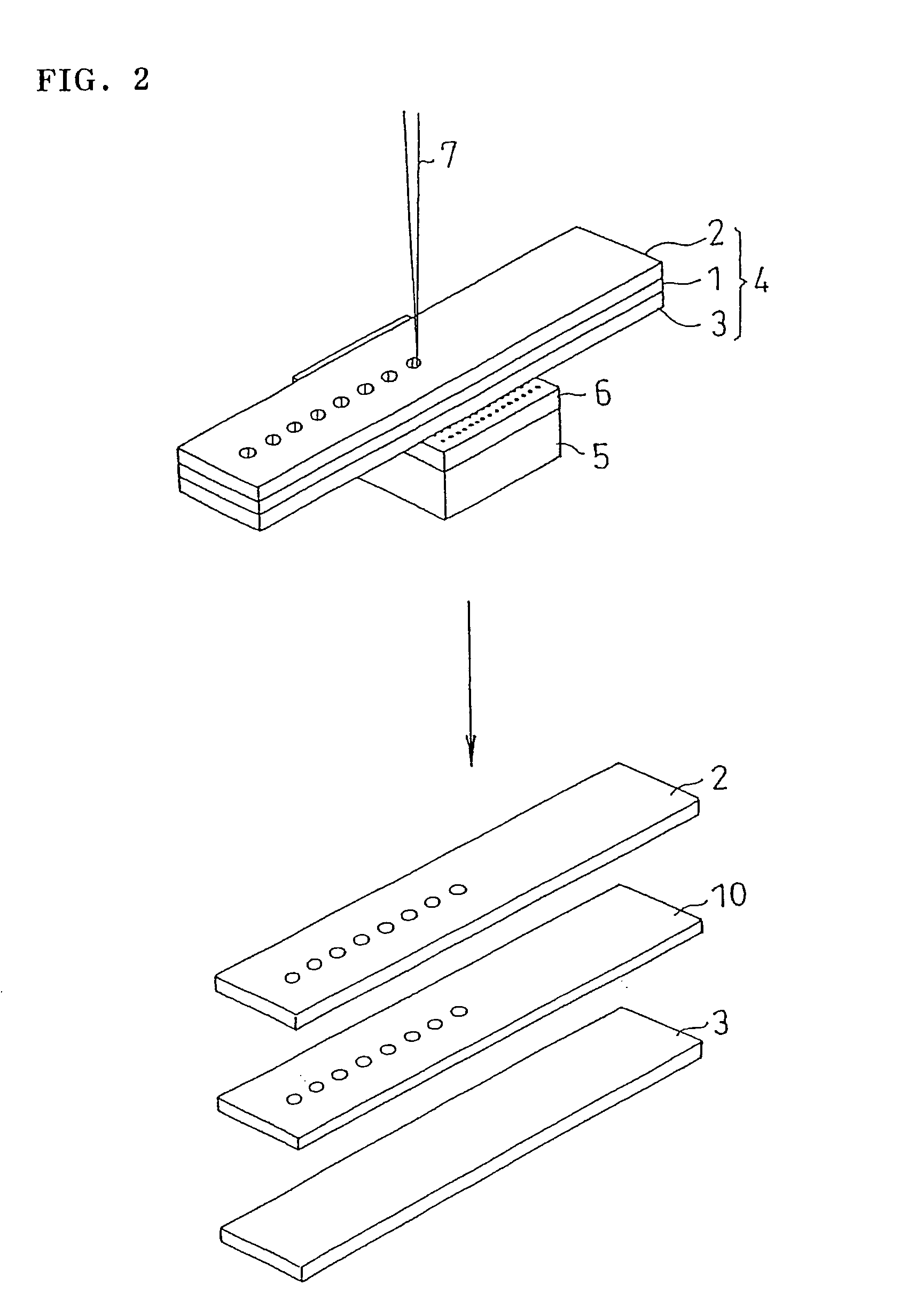Manufacturing method of laser processed parts and protective sheet for laser processing
a manufacturing method and technology for laser processing, applied in the direction of metal-working equipment, electrical equipment, basic electric elements, etc., can solve the problems of difficult to remove aftertreatment deposits, inability to meet demand, and inability to drill or drill with conventional drills or dies, etc., to achieve effective suppression of surface contamination of workpieces and high precision
- Summary
- Abstract
- Description
- Claims
- Application Information
AI Technical Summary
Benefits of technology
Problems solved by technology
Method used
Image
Examples
example 1
[0085] As workpiece, triacetyl cellulose sheet (thickness 80 μm, extinction coefficient 11 cm−1) was used. On a cellophane film (thickness 20 μm), ultraviolet curable acrylic adhesive solution (1) was applied and dried, and an adhesive layer (thickness 10 μm) was formed, and a protective sheet (extinction coefficient 37 cm−1) was manufactured. Extinction coefficient ratio was 3.4.
[0086] The acrylic adhesive solution (1) was prepared in the following method. In 650 parts by weight of toluene, 100 parts by weight of acrylic polymer of number-average molecular weight of 800,000 prepared by copolymerization of butyl acrylate / ethyl acrylate / 2-hydroxy ethyl acrylate / acrylic acid at ratio by weight of 60 / 40 / 4 / 1, 90 parts by weight of dipentaerythritol monohydroxy pentacrylate as photopolymerizable compound, 5 parts by weight of benzyl dimethyl ketal (Irgacure 651) as photopolymerization initiator, and 2 parts by weight of polyisocyanate type cross-linking agent (Coronate L manufactured by...
example 2
[0091] Polypropylene sheet(thickness 100 μm, extinction coefficient 15.9 cm−1) was used as workpiece. Polypropylene sheet with protective sheet was manufactured in the same procedure as in example 1, except that polyimide film (thickness 25 μm) was used as base material of protective sheet instead of cellophane film. The extinction coefficient of protective sheet was 54.6 cm−1. Extinction coefficient ratio was 3.4.
[0092] On a film (thickness 25 μm) of ethylene-vinyl acetate copolymer, acrylic adhesive solution (1) was applied and dried, and an adhesive layer (thickness 10 μm) was formed, and an adhesive sheet was manufactured. The adhesive sheet was glued to the back side of the polypropylene sheet with protective sheet, and polypropylene sheet with protective and adhesive sheet was manufactured. By cutting and processing in the same manner as in example 1, the protective sheet and polypropylene sheet were cut off, but the adhesive sheet was not cut off. By emitting infrared ray to...
example 3
[0093] Silicon wafer (thickness 100 μm) was used as material to be processed. Silicon wafer with protective sheet was manufactured in the same procedure as in example 1, except that polyethylene naphthalate (thickness 50 μm) was used as base material of protective sheet instead of cellophane film. The extinction coefficient of protective sheet was 76.3 cm−1.
[0094] On a film (thickness 100 μm) of polyethylene, acrylic adhesive solution (1) was applied and dried, and an adhesive layer (thickness 10 μm) was formed, and an adhesive sheet was manufactured. The adhesive sheet was glued to the back side of the silicon wafer with protective sheet, and silicon wafer with protective and adhesive sheet was manufactured. By cutting and processing in the same manner as in example 1, the protective sheet and silicon wafer were cut off, but the adhesive sheet was not cut off. By emitting infrared ray to the protective sheet, the adhesive layer was cured. The protective sheet was peeled off, and t...
PUM
| Property | Measurement | Unit |
|---|---|---|
| Nanoscale particle size | aaaaa | aaaaa |
| Extinction coefficient | aaaaa | aaaaa |
Abstract
Description
Claims
Application Information
 Login to View More
Login to View More - R&D
- Intellectual Property
- Life Sciences
- Materials
- Tech Scout
- Unparalleled Data Quality
- Higher Quality Content
- 60% Fewer Hallucinations
Browse by: Latest US Patents, China's latest patents, Technical Efficacy Thesaurus, Application Domain, Technology Topic, Popular Technical Reports.
© 2025 PatSnap. All rights reserved.Legal|Privacy policy|Modern Slavery Act Transparency Statement|Sitemap|About US| Contact US: help@patsnap.com



